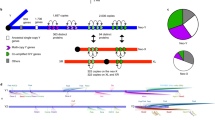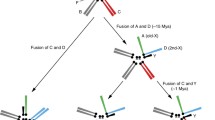Abstract
Y chromosome evolution is characterized by the expansion of genetic inertness along the Y chromosome and changes in the chromosome structure, especially the tendency of becoming heterochromatic. It is generally assumed that the sex chromosome pair has developed from a pair of homologues. In an evolutionary process the proto-Y-chromosome, with a very short differential segment, develops in its final stage into a completely heterochromatic and to a great extends genetically eroded Y chromosome. The constraints evolving the Y chromosome have been the objects of speculation since the discovery of sex chromosomes. Several models have been suggested. We use the exceptional situation of the in Drosophila mirandato analyze the molecular process in progress involved in Y chromosome evolution. We suggest that the first steps in the switch from a euchromatic proto-Y-chromosome into a completely heterochromatic Y chromosome are driven by the accumulation of transposable elements, especially retrotransposons inserted along the evolving nonrecombining part of the Y chromosome. In this evolutionary process trapping and accumulation of retrotransposons on the proto-Y-chromosome should lead to conformational changes that are responsible for successive silencing of euchromatic genes, both intact or already mutated ones and eventually transform functionally euchromatic domains into genetically inert heterochromatin. Accumulation of further mutations, deletions, and duplications followed by the evolution and expansion of tandem repetitive sequence motifs of high copy number (satellite sequences) together with a few vital genes for male fertility will then represent the final state of the degenerated Y chromosome.
Similar content being viewed by others
References
Barrio, E., A. Latorre, A. Moya & F.J. Ayala, 1992. Phylogenetic reconstruction of the Drosophila obscuragroup, on the basis of mitochondrial DNA. Mol. Biol. Evol. 9: 621–635.
Beverly, S.M. & A.C. Wilson, 1984. Molecular evolution in Drosophilaand the higher Diptera II. A time scale for fly evolution. J. Mol. Evol. 21: 1–23.
Bonaccorsi, S., C. Pisano, F. Puoti & M. Gatti, 1988. Y chromosome loops in Drosophila melanogaster. Genetics 120: 1015–1034.
Bridges, C.B., 1916a. Non-disjunction as proof of the chromosome theory of heredity. Genetics 1: 1–52.
Bridges, C.B., 1916b. Non-disjunction as proof of the chromosome theory of heredity. Genetics 1: 107–163.
Bull, J.J., 1983. Evolution of Sex Determining Mechanisms, Benjamin/ Cummings, Menlo Park, CA, pp. 248–269.
Burgoyne, P.S., 1998. The mammalian Y chromosome: a new perspective. BioEssays 20: 363–366.
Charlesworth, B., 1978. A model for the evolution of Y chromosomes and dosage compensation. Proc. Natl. Acad. Sci. USA 75: 5618–5622.
Charlesworth, B., 1991. The evolution of sex chromosomes. Science 251: 1030–1033.
Charlesworth, B., 1996. The evolution of chromosomal sex determination and dosage compensation. Current Biology 6: 149–162.
Charlesworth, B., D. Charlesworth, J. Hnilicka, A. Yu & D.S. Guttman, 1997. Lack of degeneration loci on the neo-Ychromosome of Drosophila americana americana. Genetics 145: 989–1002.
Dobzhansky, Th., 1935. Drosophila miranda, a new species. Genetics 20: 377–391.
Eichler, E.E., 1998. Masquarading repeats: paralogous pitfalls of the human genome. Genome Res. 8: 758–762.
Fridolfsson, A.-K., H. Cheng, G.N. Copeland, N.A. Jenkins, H.-C. Liu, T. Raudsepp, T. Woodage, B. Chowdhary, J. Halverson, H. Ellegren, 1998. Evolution of the avian sex chromosomes from an ancestral pair of autosomes. Proc. Natl. Acad. Sci. USA 95: 8147–8152.
Gatti, M. & S. Pimpinelli, 1983. Cytological and genetic analysis of the Y chromosome of Drosophila melanogaster: I. Organization of the fertility factors. Chromosoma 88: 349–373.
Gatti, M. & S. Pimpinelli, 1992. Functional elements in Drosophila melanogasterheterochromatin. Annu. Rev. Genet. 26: 239–275.
Gepner, J. & T.S. Hays, 1993. A fertility region on the Y chromosome of Drosophila melanogasterencodes a dynein microtubule motor. Proc. Natl. Acad. Sci. USA 90: 11132–11136.
Graves, J.A.M., 1995. The origin and function of the mammalian Y chromosome and Y-borne genes – an evolving understanding. BioEssays 17: 311–320.
Graves, J.A.M., 1996. Mammals that break the rules: genetics of marsupials and monotremes. Annu. Rev. Genet. 30: 233–260.
Graves, J.A.M., C.M. Disteche & R. Toder, 1998. Gene dosage in the evolution and function of mammalian sex chromosomes. Cytogenet. Cell Genet. 80: 94–103.
Hackstein, J.H.P., 1987. Spermatogenesis in Drosophila hydei, pp. 63–116 in Results and Problems in Cell Differentiation (Spermatogenesis: Genetic Aspects, Vol. 15), edited by W. Hennig, Springer-Verlag, Berlin.
Hackstein, J.H.P. & R. Hochstenbach, 1995. The elusive fertility genes of Drosophila: the ultimate haven for selfish genetic elements. Trends Genet. 11: 195–200.
Hardy, R.W., K.T. Tokuyasu & D.L. Lindsley, 1981. Analysis of spermatogenesis in Drosophila melanogasterbearing deletions for Y-chromosome fertillity genes. Chromosoma 88: 593–617.
Hess, O., 1967. Complementation of genetic activities in translocated fragments of the Y chromosome in Drosophila hydei. Genetics 56: 283–295.
Kumar, S. & S.B. Hedges, 1998. A molecular timescale for vertebrate evolution. Nature 392: 917–920.
Kurek, R., A.M. Reugels, K.H. Glätzer & H. Bünemann, 1998. The Y chromosomal fertility factor Threads in Drosophila hydeiharbors a functional gene encoding an axonemal dynein b heavy chain protein. Genetics 149: 1363–1376.
Labrador, M. & V.G. Corces, 1997. Transposable element–host interactions: regulation of insertion and excision. Annu. Rev. Genet. 31: 381–404.
Lahn, B.T. & D.C. Page, 1997. Functional coherence of the human Y chromosome. Science 278: 675–680.
Lahn, B.T. & D.C. Page, 1999. Four evolutionary strata on the human X chromosome. Science 286: 964–967.
Lohe, A.R. & A.J. Hilliker, 1995. Return of the H-word (heterochromatin). Curr. Opin. Genet. Dev. 5: 746–755.
Lucchesi, J.C., 1978. Gene dosage compensation and the evolution of sex chromosomes. Science 202: 711–716.
Lucchesi, J.C., 1994. The evolution of heteromorphic sex chromosomes. BioEssays 16: 81–83.
Lucchesi, J.C., 1996. Dosage compensation in Drosophilaand the ‘complex’ world of transcriptional regulation. BioEssays 18: 541–547.
MacKnight, R.H., 1939. The sex-determining mechanism of Drosophila miranda. Genetics 24: 180–201.
Marsh, J.L. & E. Wieschaus, 1978. Is sex determination in germ line and soma controlled by separate genetic mechanisms? Nature 272: 249–251.
McAllister, B.F. & B. Charlesworth, 1999. Reduced sequence variability on the neo-Ychromosome of Drosophila americana americana. Genetics 153: 221–233.
Muller, H.J., 1918. Genetic variability, twin hybrids and constant hybrids, a case of balanced lethal factors. Genetics 3: 422–499.
Muller, H.J., 1932. Some genetic aspects of sex. Am. Nat. 66: 118–138.
Muller, H.J., 1940. Bearings of the Drosophilawork on systematics pp. 185–268 in The New Systematics edited by I. Huxley. Oxford University Press, Oxford.
Ohno, S. 1967. Sex chromosomes and Sex-Linked Genes. Springer, Berlin.
Pimpinelli, S., M. Berloco, L. Fanti, P. Dimitri, S. Bonaccorsi, E. Marchetti, R. Caizzi, C. Caggese & M. Gatti, 1995. Transposable elements are stable structural component of Drosophila melanogasterheterochromatin. Proc. Natl. Acad. Sci. USA 92: 3804–3808.
Rice, W.R., 1987. Genetic hitchhiking and the evolution of reduced genetic activity of the Y sex chromosome. Genetics 116: 161–167.
Rice, W.R., 1994. Degeneration of a non-recombining chromosome. Science 263: 230–232.
Rice, W. R., 1996. Evolution of the Y sex chromosome in animals. BioScience 46: 331–343.
Russo, C.A.M., N. Takezaki & M. Nei, 1995. Molecular phylogeny and divergence times of Drosophilid species. Mol. Biol. Evol. 12: 391–404.
Sharman, G., R. Hughes & D. Cooper, 1990. The chromosomal basis of sex differentiation in marsupials. Aust. J. Zool. 37: 451–466.
Spradling, A.C., 1994. Transposable elements and the evolution of heterochromatin, pp. 69–83 in Molecular Evolution of Physiological Processes, edited by D. Fambrough. Rockefeller University Press, New York.
Steinemann, M., 1982. Multiple sex chromosomes in Drosophila miranda: A system to study the degeneration of a chromosome. Chromosoma 86: 59–76.
Steinemann, M. & S. Steinemann, 1992. Degenerating Y chromosome of Drosophila miranda: A trap for retrotransposons. Proc. Natl. Acad. Sci. USA 89: 7591–7595.
Steinemann, M. & S. Steinemann, 1993. A duplication including the Yallele of Lcp2and the TRIMretrotransposon at the Lcplocus on the degenerating neo-Ychromosome of Drosophila miranda: Molecular structure and mechanisms by which it may have arisen. Genetics 134: 497–505.
Steinemann, M., S. Steinemann & F. Lottspeich, 1993. How Y chromosomes become genetically inert. Proc. Natl. Acad. Sci. USA 90: 5737–5741.
Steinemann, M., S. Steinemann & B. M. Turner, 1996. Evolution of dosage compensation. Chromosome Res. 4: 185–190.
Steinemann, M. & S. Steinemann, 1998. Enigma of Ychromosome degeneration: Neo-Yand Neo-Xchromosomes of Drosophila mirandaa model for sex chromosome evolution. Genetica 102/103: 409–420.
Steinemann, S. & M. Steinemann, 1999. The Amylasegene cluster on the evolving sex chromosomes of Drosophila miranda. Genetics 151: 151–161.
Throckmorton, L.H., 1982. The virilisspecies group, pp. 227–296 in The Genetics and Biology of Drosophila, edited by M. Ashburner, H.L. Carson & J.N. Thomson. Academic Press, London.
Tomlinson, I., G. Cook, N. Carter, R. Elaswarapu, S. Smith, G. Walter, L. Buluwela, T. Rabbitts & G. Winter, 1994. Human immunglobulin VH and D segments on chromosomes 15q11.2 and 16p11.2. Hum. Mol. Genet. 3: 853–860.
Vogt, P.H., N. Affara, P. Davey, M. Hammer, M.A. Jobling, Y.-F.C. Lau, M. Mitchell, W. Schempp, C. Tyler-Smith, G. Williams, P. Yen & G.A. Rappold, 1997. Report of the third international workshop on human Ychromosome mapping. Cytogenet. Cell Genet. 79: 1–20.
Zhang, P. & R.L. Stankiewicz, 1998. Y-linked male sterile mutations induced by P element in Drosophila melanogaster. Genetics 150: 735–744.
Author information
Authors and Affiliations
Rights and permissions
About this article
Cite this article
Steinemann, M., Steinemann, S. Common Mechanisms of Y Chromosome Evolution. Genetica 109, 105–111 (2000). https://doi.org/10.1023/A:1026584016524
Issue Date:
DOI: https://doi.org/10.1023/A:1026584016524




